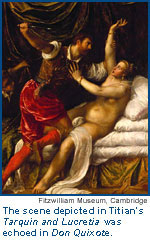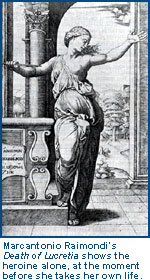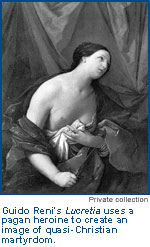A Quixotic Museum: Cervantes and Italian Renaissance Art
by Frederick A. de Armas
 uring the last months of 1569, the 22-year-old Cervantes travels to Italy and enters the service of the soon-to-be Cardinal, Giulio Acquaviva in Rome. Cervantes came to Italy after studying in Madrid with the Spanish humanist Juan Lspez de Hoyos and after writing his first verse compositions, which imitated Garcilaso, using his metrical forms, adjectives and themes. Cervantes' brief humanistic training, and his interest in Garcilaso, who was deeply influenced by the Italian Renaissance, prepares him for an Italian sojourn. It was a Rome teeming with ruins, which impelled humanists and artists of the Renaissance to turn to archeological pursuits, to focus their attention on rediscovering antiquity, finding in the ancients "a powerful impetus to revive the contemporary world in light of its accomplishments."
uring the last months of 1569, the 22-year-old Cervantes travels to Italy and enters the service of the soon-to-be Cardinal, Giulio Acquaviva in Rome. Cervantes came to Italy after studying in Madrid with the Spanish humanist Juan Lspez de Hoyos and after writing his first verse compositions, which imitated Garcilaso, using his metrical forms, adjectives and themes. Cervantes' brief humanistic training, and his interest in Garcilaso, who was deeply influenced by the Italian Renaissance, prepares him for an Italian sojourn. It was a Rome teeming with ruins, which impelled humanists and artists of the Renaissance to turn to archeological pursuits, to focus their attention on rediscovering antiquity, finding in the ancients "a powerful impetus to revive the contemporary world in light of its accomplishments."
It should come as no surprise, then, that throughout his literary works, Cervantes repeatedly represents a desire for Italy. This desire often takes the form of evocations and descriptions of the art and architecture of the Italian peninsula. In many cases, these moments carry a second, deeper and more concealed aspiration, that of recapturing the ancient world. This desire for Italy is inscribed even in the last text written by Cervantes. In the fourth and last book of the Persiles y Sigismunda, Cervantes takes the pilgrims to Rome and shows them a breathtaking view of the city. They must descend through Monte Mario and pass the gardens of Madama in order to enter the city. These gardens surround a villa designed by Raphael. Ancient and Renaissance architecture comes together in this building, thus bringing together two of Cervantes' major motifs.
In addition to architecture, Cervantes' fiction often incorporates allusions to Italian Renaissance art. In this sense, these works can be viewed as proto-museums. As Anthony Grafton reminds us: "A network of museums . . . grew up across Europe in the later sixteenth and seventeenth centuries. From Oxford to Vienna, from Naples to Nuremberg, kings and merchants, doctors and professors set spaces aside for collections of the wonderful works of nature and art." But Cervantes' museums of words lack a unified pictorial program. Instead, they include several small exhibits or interconnected rooms.
I would like to explore one room in this literary museum--the room devoted to the most famous female figure in Don Quixote, Dulcinea--by looking at how Don Quixote painted in his mind an image of his lady in chapter 25 of the novel. In an attempt to understand Don Quixote's composition, I will use an anecdote from art history, treatises on the art of memory, a Spanish and an Italian text, and paintings from the Italian Renaissance.
In chapter 25, Don Quixote explains to Sancho how he has created Dulcinea out of Aldonza: "In my imagination I draw her as I would have her be, both as to her beauty and her rank; unequaled by Helen, unrivaled by Lucretia or any other famous woman of antiquity, Greek, Barbarian, or Roman" (1.25.210-11). The reference to Helen, the use of five examples and the notion that no one woman can embody the perfection of beauty found in Dulcinea, brings to mind a classical anecdote. In his attempt to paint the perfect woman, Don Quixote may be following the example of the Greek painter Zeuxis. His manner of painting perfection is found in Pliny's Natural History. When Zeuxis is asked to paint the most beautiful of women, Helen, for the temple of Juno, he comes up with a specific method. The painter chooses five women from the city as models "because he did not think that all the qualities he sought to combine in a portrayal of beauty could be found in one person, because in no single case has Nature made anything perfect and finished in every part." Thus, the knight creates Dulcinea from the most ideal models he knows--like the Helen of Zeuxis. And, like Zeuxis, he will point to five key models, all of which appear in chapter 25. But unlike the Greek painter, he does not choose all his models from nature. The knight will attempt to surpass Zeuxis by including imitations from nature and art, the latter including texts and images.
Also, in contradistinction to the Greek painter, Don Quixote will draw Dulcinea in his mind. For this, he will follow the dictates of the art of memory. This ancient technique, which often involved the placing of images in architectural backgrounds or loci such as monasteries and palaces, was very popular in the Renaissance. Giambattista Della Porta's L'Arte del Ricordare (The Art of Memory) was published only four years before Cervantes' arrival in Naples, a city that viewed Della Porta as one of its greatest writers. Della Porta as well as many other authors of mnemonic treatises argues that five is the ideal number of images to be placed together. Furthermore, Della Porta asserts that artificial mnemonics should rely on painting, and particularly on the best of Italian art: "It is useful to take pictures by good artists as memory images for these are more striking and move more than pictures by ordinary painters. For example, pictures by Michelangelo, Raphael, Titian, stay in the memory." Although Don Quixote often creates images from the texts he reads in order to place these in his memory, he also utilizes Italian art as recommended by Della Porta. And it is precisely works by Titian, Raphael and by a disciple of Raphael that serve to create Dulcinea in one of the rooms of the Quixotic museum.
Don Quixote wishes to convert his visit to Sierra Morena into a prolonged meditation on Dulcinea. But he does not know which model to follow: Should he do penance like Amadís for the jealous Oriana, as in Montalvo's Amadís; or should he imitate the madness that seized Orlando when he discovered Angelica's love for Medoro, in Ariosto's Orlando furioso? Thus, as several critics have pointed out, Don Quixote uses the notion of imitation to become the artist or writer of his own life. Indeed, the two knights and the two ladies the knight has chosen have a deep connection to his fears and desires.
Don Quixote asserts that "great beauty and a good name" are the two qualities that "arouse love more than all others" (1.25.210) The chaste and beautiful Oriana is often portrayed in the woodcuts of editions Don Quixote would have read, and he may place her in his memory as such. In one such illustration, Oriana is seen in front of the Arch of Loyal Lovers and next to a magical chamber. She triumphs in these two trials, just as Amadís had done before her. Don Quixote, then, may wish to paint this triumph in his memory, and the arches in the illustration may recall a loggia, a perfect location to place a mnemonic image. But Amadís, as Don Quixote reminds Sancho, did penance in Peña Pobre when his lady, Oriana, thought he was unfaithful with Briolanja. Like Amadís, Don Quixote is not totally without blame, as we will see.
But he balances Oriana's image with that of Angelica. Here, the woman turns away from Orlando in order to love Medoro. Don Quixote acknowledges Angelica's beauty and thus places her in his memory. By turning from Oriana to Angelica, Don Quixote is transferring his guilt to the woman. Eventually, the knight concludes that he will also turn away from Orlando's madness since: "I will swear that my Dulcinea del Toboso has never seen a real Moor. . .in all her life" (1.26.215). Once again, Don Quixote is lying to himself and to Sancho. The town of El Toboso, where Dulcinea/Aldonza resides, at least doubled in population after many moriscos settled there when they were expelled from Granada in 1569.
These two texts, the Spanish Amadís and the Italian Orlando furioso, and their pictoric representations, then, have provided the knight with traits with which to paint his image of Dulcinea. This is a complex and conflictive drawing, one that points to both his and her guilt; one that delights in the noble provenance of the lady and casts doubts as to her and her lover's Christian ancestry. But Zeuxis tells us that five models are needed. Don Quixote, as we have noted, asserts that he paints Dulcinea in his imagination as Helen and Lucretia (1.25.314).
Don Quixote may wish to place Helen in his memory as she was drawn by Zeuxis. But the knight has neither the painting nor a description of it available to him. Most Renaissance paintings dealing with the abduction of Helen show her transported by force. Indeed, the Spanish painter Juan de la Corte portrays her thus. Helen is held by a soldier and is guarded by Hercules wearing lion skins, as she is transported by boat to a galleon at sea. Don Quixote thus sees Helen as a lady in distress and even transgenders Sancho at one point, comparing him to the most beautiful of women and assuring him that he will save him from Troy (the dangers of the Inn). But later in the novel, Don Quixote views a tapestry at a different inn: "On one of them some wretched dauber had depicted the rape of Helen at the moment when the bold guest stole her from Menelaus. . .Helen went with no very ill grace, for she was slyly smiling to herself" (2.72.924). A tapestry from a famous series on the Trojan War now hanging at the church of Zamora shows Helen being joyfully taken. But its model is a medieval text that talks of sibyls and seeks to exonerate Paris. The tone of the Quixotic image comes much closer to that of a Renaissance fresco, Giulio Romano's The Rape of Helen in the Sala di Troia at the Ducal Palace in Mantua. Giulio's fresco shows how Helen enters her captor's boat willingly, beckoning her servants, so as to hurry them along. There is no rape of Helen, but a joyous departure to be with Paris. There is a kinship, then, between the badly painted cloth seen by Don Quixote and Giulio's famous fresco. In the Italian painting, her lips are parted in what could be taken as the beginnings of a smile. Her exposed breast confirms an erotic intent that is allegorized by a winged cupid above. But why is Giulio called a wretched dauber? For Don Quixote, the painted Helen, like the textual Angelica, become images of joyous eroticism and hedonistic abandon that he turns into sites of culpability.
 If this was Don Quixote's third model for Dulcinea, the fourth could not be more opposite. Lucretia was often conceived as the epitome of the chaste woman, who chose suicide over dishonor after being raped. It is most fitting that Don Quixote chose her for the palace of his mind since Della Porta gives a lengthy description of how to place this story in the memory. Perhaps the most famous Renaissance representation is a painting by Titian. Could Don Quixote be picturing the ideal and chaste Lucretia at the moment of rape? There are elements in the painting that recall Don Quixote's encounter with Maritornes in Chapter 16, an episode that has been mainly studied as a ludic interlude or bedroom farce. In the Italian canvas, Sextus holds on to Lucretia's arm while she reclines on the bed. On seeing Maritornes, Don Quixote "seized her tightly by one wrist and drawing her to him, she not daring to say a word, forced her to sit on his bed" (1.16.122). The similarities are thus striking. Furthermore, the knight decides to paint over this rather grotesque looking servant into a princess from the romances. Again, her description fits Titian's Lucretia. Maritornes' hair becomes as golden as that pictured by Titian. Lucretia's arms in the painting are adorned with bracelets that could fit the double description by Don Quixote: they are encrusted with "glass beads" or "rare orient pearls" (1.16.122). In Titian's canvas, Lucretia attempts to disengage herself from the threatening Sextus. With one arm she pushes him away, while he holds on to her other arm. Maritornes also battles the knight: "the maid struggling to break loose and Don Quixote trying to hold her" (1.16.204). And finally, the painting shows a figure at the foot of the bed, a slave watching the scene. This voyeur also appears in the novel. The muleteer who was awaiting Maritornes' visit, on seeing her with Don Quixote, "edged nearer and nearer to Don Quixote's bed" (1.16.123).
If this was Don Quixote's third model for Dulcinea, the fourth could not be more opposite. Lucretia was often conceived as the epitome of the chaste woman, who chose suicide over dishonor after being raped. It is most fitting that Don Quixote chose her for the palace of his mind since Della Porta gives a lengthy description of how to place this story in the memory. Perhaps the most famous Renaissance representation is a painting by Titian. Could Don Quixote be picturing the ideal and chaste Lucretia at the moment of rape? There are elements in the painting that recall Don Quixote's encounter with Maritornes in Chapter 16, an episode that has been mainly studied as a ludic interlude or bedroom farce. In the Italian canvas, Sextus holds on to Lucretia's arm while she reclines on the bed. On seeing Maritornes, Don Quixote "seized her tightly by one wrist and drawing her to him, she not daring to say a word, forced her to sit on his bed" (1.16.122). The similarities are thus striking. Furthermore, the knight decides to paint over this rather grotesque looking servant into a princess from the romances. Again, her description fits Titian's Lucretia. Maritornes' hair becomes as golden as that pictured by Titian. Lucretia's arms in the painting are adorned with bracelets that could fit the double description by Don Quixote: they are encrusted with "glass beads" or "rare orient pearls" (1.16.122). In Titian's canvas, Lucretia attempts to disengage herself from the threatening Sextus. With one arm she pushes him away, while he holds on to her other arm. Maritornes also battles the knight: "the maid struggling to break loose and Don Quixote trying to hold her" (1.16.204). And finally, the painting shows a figure at the foot of the bed, a slave watching the scene. This voyeur also appears in the novel. The muleteer who was awaiting Maritornes' visit, on seeing her with Don Quixote, "edged nearer and nearer to Don Quixote's bed" (1.16.123).
According to Della Porta, memory images should partake of either or both the comic and the heroic, and this is precisely what happens in the conflation of Titian's painting with the farce at the Inn. Della Porta also claims that erotic images are easy to remember. Although Titian's painting has as theme Lucretia's chastity, it also displays Lucretia's body. Don Quixote reflects the conflict in the painting. He both idealizes the chaste Dulcinea and is tempted to hold on to the female body against her will (as in the case of Maritornes).
 Even if Don Quixote placed this painting in his memory, he would never acknowledge that he could be threatening to women or that he cared to view them in revealing postures. After all, he considers himself a Platonic lover and a defender of ladies in distress. In addition, he would have Sancho imagine that he is viewing Dulcinea/Lucretia as a proto-saint, as the embodiment of chastity. Other Renaissance paintings show Lucretia alone after the rape, a knife like the one Tarquin holds in Titian's painting in her hand. This is the moment when she wills her own death.
Even if Don Quixote placed this painting in his memory, he would never acknowledge that he could be threatening to women or that he cared to view them in revealing postures. After all, he considers himself a Platonic lover and a defender of ladies in distress. In addition, he would have Sancho imagine that he is viewing Dulcinea/Lucretia as a proto-saint, as the embodiment of chastity. Other Renaissance paintings show Lucretia alone after the rape, a knife like the one Tarquin holds in Titian's painting in her hand. This is the moment when she wills her own death.
 But to better understand this version of the pictorial Lucretia, it is best to look at one of Guido Reni's depictions, although his works were painted more than 20 years after the publication of the first part of Don Quixote. As Richard E. Spear explains, Reni "designed at least 10 different representation of Lucretia and Cleopatra committing suicide" (84), all of which were "phenomenally popular" (83). This popularity may have had to do with the bringing together of opposing elements: "the mood of a quasi-Christian martyrdom" (Spear 89) with an expression "of detachment from reality and an inward bliss that can suggest sexual gratification" (Spear 98). Dulcinea can thus exude the perfection of approaching martyrdom. This intimation of perfection can sanction a different type of male delectation, which Richard Spear describes as "the iniquitous excitement derived from watching women suffer in extremis" (Spear 86).
But to better understand this version of the pictorial Lucretia, it is best to look at one of Guido Reni's depictions, although his works were painted more than 20 years after the publication of the first part of Don Quixote. As Richard E. Spear explains, Reni "designed at least 10 different representation of Lucretia and Cleopatra committing suicide" (84), all of which were "phenomenally popular" (83). This popularity may have had to do with the bringing together of opposing elements: "the mood of a quasi-Christian martyrdom" (Spear 89) with an expression "of detachment from reality and an inward bliss that can suggest sexual gratification" (Spear 98). Dulcinea can thus exude the perfection of approaching martyrdom. This intimation of perfection can sanction a different type of male delectation, which Richard Spear describes as "the iniquitous excitement derived from watching women suffer in extremis" (Spear 86).
Don Quixote creates an image of Dulcinea that has many facets for contemplation: Lucretia the martyr, the woman in distress; and Lucretia the Maritornes whom he held against her will in his own bed. They are accompanied by Helen, the most beautiful, the seeker of erotic pleasures; the sinned against Oriana; and the sinful Angelica, attracted by Moorish pleasures. But there is one element missing, the fifth woman who must complete the image of Dulcinea that Don Quixote will place in the memory palace of his mind.
The conflictive portrayals given by the knight and his squire of Aldonza Lorenzo add to the many tensions already found in the mnemonic image that Don Quixote is attempting to paint in his memory. The recollection of the peasant woman is particularly useful to the mnemonic composition because a strong emotion is key to memory, according to both Quintillian and Della Porta. Thus, the knight's feelings for Aldonza form the last element in the construction of Dulcinea. Her image is now etched forever in his memory.
While attempting to paint the perfect beauty according to Zeuxis' notions, Don Quixote has actually succeeded in drawing a monstrous body. For he has been betrayed by the treacherous and erotic landscape of his mind and by his own readings--the compositional problems of the romances of chivalry. Thus, the knight's monstrous readings and his inability to control his invention have led him to create a monstrous woman. But there are, perhaps, less problematic purposes in this creation. Henry Higueras contends that: "Don Quixote wants to conquer the world out of love for Dulcinea del Toboso, his ladylove. His love for her, he thinks, inspires his whole imperial project" (185). I would argue that in Don Quixote's map of empire, Helen represents the Greeks and Lucretia the Romans. Both are in a rather unstable position in regards to the land they embody. The other three women represent a map of the present. Oriana, as daughter of the king of Great Britain, stands for Spain's rival at sea, recalling the defeat of the Armada and the English sack of Cadiz. Angelica represents the non-European Other. She is daughter of the ruler of Cathay (Asia) and loves an African Moor, Medoro. She stands for Cervantes' continuing concern with Algerian corsairs and Islamic control of the Mediterranean. Finally, Aldonza must represent Spain. Not surprisingly, she is a most conflictive figure, and not at all the proud woman who helps religion in Titian's painting. She is an exalted princess and a peasant who evinces Moorish ancestry.
From the start, then, Don Quixote's imperial project, his desire to "conquer" Dulcinea, is doomed. For the knight is as conflicted about women's bodies as he is about his own home and his imperial project. His portrayal of Dulcinea draws on a classical anecdote and on Renaissance art and literature in order to create a perfect beauty, a goddess. But the result seems to be a monstrous and conflictive body, which he constantly denies. Even though Don Quixote fails to create his perfect Dulcinea, he succeeds in making her unforgettable. She is housed in the palace of his memory in such a way that she becomes impossible to dislodge. Her image carries with it all the attributes necessary for artificial mnemonics to create indelible images: chaste perfection and erotic depictions, the heroic and the ridiculous, the emotional and the imaginative, the brutish and the beautiful. Dulcinea's image must be captured, must be enchanted, must be restrained, for, in her memory palace, she holds sway over the violent, exotic and erotic demons of the knight's mind.
ABOUT THE AUTHOR |
Frederick A. de Armas
 Frederick A. de Armas is Andrew W. Mellon Professor in Humanities at the
University of Chicago. A University of North Carolina Ph.D. he has taught
at Pennsylvania State University where he was Sparks Professor of Spanish
and Comparative Literature. His books and edited collections include: The
Invisible Mistress: Aspects of Feminism and Fantasy in the Golden Age
(1976); The Return of Astraea: An Astral Imperial Myth in Calderon (1986);
The Prince in the Tower: Perspectives on "La vida es sueno" (1993); A
Star-Crossed Golden Age: Myth and the Spanish Comedia (1998); and
Cervantes, Raphael and the Classics (1998).
Frederick A. de Armas is Andrew W. Mellon Professor in Humanities at the
University of Chicago. A University of North Carolina Ph.D. he has taught
at Pennsylvania State University where he was Sparks Professor of Spanish
and Comparative Literature. His books and edited collections include: The
Invisible Mistress: Aspects of Feminism and Fantasy in the Golden Age
(1976); The Return of Astraea: An Astral Imperial Myth in Calderon (1986);
The Prince in the Tower: Perspectives on "La vida es sueno" (1993); A
Star-Crossed Golden Age: Myth and the Spanish Comedia (1998); and
Cervantes, Raphael and the Classics (1998).
COPYRIGHT | A version of this article was delivered October 27, 2001, at the University of Chicago Humanities Open House. Copyright 2001 the University of Chicago.